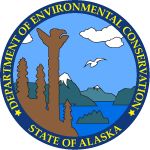| Action Date |
Action |
Description |
DEC Staff |
| 2/13/2019 |
Spill Transferred from Prevention Preparedness and Response Program |
Spill transferred by PPRP staff Gay Harpole. Spill no. 16239916701; spill date = 6/15/16; substance = diesel; quantity = ~200-250 gallons; source = overfill during a fuel transfer to a 10,000-gallon aboveground tank used to supply diesel to a fueling dispenser for the vehicle fleet. |
Mitzi Read |
| 2/14/2019 |
Site Added to Database |
A new site has been added to the database |
Mitzi Read |
| 5/6/2019 |
Potentially Responsible Party/State Interest Letter |
Potentially responsible party (PRP) letter emailed and mailed via USPS Certified Mail to RP, consultant, and ADEC SPAR Cost Recovery. Work plan requested by June 15, 2019. |
Amy Rodman |
| 5/6/2019 |
Workplan Requested |
Work plan requested within Potentially responsible party (PRP) letter, work plan due June 15, 2019. |
Amy Rodman |
| 6/7/2019 |
Site Characterization Workplan Approved |
ADEC Contaminated Sites Program has reviewed and approved the “Work Plan for Groundwater Sampling Activities, 325 East 94th Court, Anchorage, Alaska” (Work Plan) for the MOA – AWWU Maintenance and Operations Facility AST Overfill site in Anchorage, dated May 31, 2019. The work plan was submitted via email on June 3, 2019 by Shannon & Wilson, Inc. Proposed activities generally consist of sampling existing onsite groundwater monitoring wells for laboratory analysis for diesel range organics, volatile organic carbons, and polynuclear aromatic hydrocarbons (MW-1 only), along with managing investigation-derived waste. ADEC also requested GRO analysis for groundwater samples. |
Amy Rodman |
| 10/16/2019 |
Site Characterization Report Approved |
ADEC has reviewed and approved the “Groundwater Sampling Activities, 325 East 94th Court, Anchorage” (Report) for the MOA AWWU Maintenance and Operations Facility Diesel AST Overfill site in Anchorage, AK dated October 7, 2019. The report was submitted to ADEC via email on October 8, 2019 by Shannon & Wilson, Inc. (Shannon & Wilson). Field activities were conducted on June 14 and September 21, 2019 and generally consisted of conducting monitoring well surveys and sampling groundwater for laboratory analysis. A work plan to address the groundwater ingestion exposure pathway is due November 29. |
Amy Rodman |
| 11/25/2019 |
Update or Other Action |
Per consultant's email: fueling station relocation is planned for 2021. Work plan in progress and will include groundwater characterization. |
Amy Rodman |
| 5/15/2020 |
Update or Other Action |
Nearby contamination discovered during a geotechnical exploration in support of a building design project. See email in file. |
Kara Kusche |
| 8/14/2020 |
Meeting or Teleconference Held |
Teleconference to discuss site delineation and plans for future work. Also discussed a work plan for a new source area that was located during geotechnical investigation. The new source will be issued a separate hazard ID once information is submitted. |
Jamie Grant |
| 10/9/2020 |
Site Characterization Workplan Approved |
The site characterization work plan received on October 6, 2020 has been approved. |
Jamie Grant |
| 3/2/2021 |
Document, Report, or Work plan Review - other |
A Final Site Characterization Report was submitted on behalf of AWWU on March 2, 2021 for work conducted in October 2020. The field activities consisted of advancing four soil borings, installing three groundwater monitoring wells using a GeoProbe® direct-push drill rig to an approximate depth of approximately 10 feet below ground surface (bgs). Analytical soil and groundwater samples were collected in an effort to delineate the area of contamination. Borings B12, B13, and B14 were advanced northeast, south, and southwest of the ASTs, respectively. Boring B15 was advanced northwest of Well MW-2. Elevated field screening results or evidence of
contamination (fuel odors, staining, etc.) were not observed. Therefore, step-out borings were not advanced. The soil was collected from each boring in 5 foot sections which was then divided into 2.5 foot intervals for screening and sampling. Four analytical soil samples were selected for laboratory analysis based on the highest field screening results. Borings B12, B13, and B15 were then advanced to approximately 14 to 15 feet bgs to facilitate the installation of groundwater monitoring wells (MW-4, MW-5, and MW-6). Analytical results for soil indicate detectable levels of DRO, trichlorofluoromethane, benzo[a]pyrene, benzo[g,h,i]perylene, fluoranthene,indeno[1,2,3-c,d]pyrene, phenanthrene, and/or pyrene in at lease one soil sample, however, all sample results were less than the most stringent ADEC Method Two cleanup levels.
The remaining tested analytes were not detected in the soil samples. Analytical results for groundwater indicate Duplicate Samples MW1 and MW11 contained concentrations of DRO (maximum of 8,460 micrograms per liter [µg/L]) and naphthalene (maximum of 2.41 µg/L) that exceed the
ADEC Table C cleanup levels of 1,500 µg/L and 1.7 µg/L, respectively. Sample MW2 contained 0.386 µg/L benzo[g,h,i]perylene and 0.216 µg/L indeno[1,2,3-c,d]pyrene, which exceed the ADEC Table C cleanup level of 0.26 µg/L and 0.19 µg/L, respectively. The remaining tested analytes were not detected at concentrations exceeding the ADEC Table C cleanup levels. MW-4, MW-5, and MW-6 did not contain contaminants above cleanup levels. Based on information in this report the extent of soil and groundwater contamination has been somewhat defined. Additional groundwater sampling will be needed to evaluate the concentration and the size of the dissolved plume over time. |
Jamie Grant |
| 3/12/2021 |
Site Characterization Report Approved |
ADEC had reviewed and approved the Site Characterization Report received on March 2, 2021. |
Jamie Grant |
| 5/26/2021 |
Long Term Monitoring Established |
ADEC has reviewed and approved a Quarterly Groundwater Monitoring Plan submitted on this day with the following condition: all samples must also be analyzed for VOCs. Samples will be collected and analyzed (DRO, VOCs, PAHs) from 6 monitoring wells each quarter beginning June 2021 and ending March 2022. |
Jamie Grant |
| 3/25/2022 |
Offsite Soil or Groundwater Disposal Approved |
Approved transport for a 55-gallong drum of petroleum-contaminated purge water at the US Ecology Viking Facility. |
Janice Wiegers |
| 8/10/2022 |
Document, Report, or Work plan Review - other |
ADEC approved the 2021/2022 quarterly groundwater monitoring report received on July 11, 2022. Monitoring Wells MW-1, MW-2, MW-4, MW-5, and MW-6 were sampled in June, September, and December 2021, and February 2022. Well MW-3 was not located during the sampling events and could not be sampled. DRO was detected in groundwater during three of the sampling events above cleanup levels. Naphthalene (maximum of 2.35 µg/L) benzo(a)pyrene, benzo[g,h,i]perylene, and indeno[1,2,3-c,d]pyrene were detected above cleanup levels in MW-1 during the June 2021 sampling event. Additional groundwater sampling at the site to further
evaluate contaminant trends has been recommended. |
Brandi Tolsma |
| 10/20/2022 |
Document, Report, or Work plan Review - other |
On this date, ADEC approved work plan to conduct annual groundwater monitoring in 2022 or 2023 depending on snow conditions. Groundwater samples will be collected from MW-1 through MW-6. One analytical sample will be collected from each well and analyzed for diesel range organics (DRO) by Alaska Method (AK) 102. The samples collected from Wells MW-1 and MW-2 will also be analyzed for volatile organic compounds (VOCs) by Environmental Protection Agency (EPA) Method 8260D and PAHs by EPA Method 8270D SIM. Based on the Mann-Kendall analysis of past sampling events, the DEC approves the request to reduce the sampling frequency from quarterly to annual. |
Brandi Tolsma |
| 3/23/2023 |
Offsite Soil or Groundwater Disposal Approved |
Approved transport of 1 55-gallon drum of petroleum contaminated water to the Viking Drive Facility. |
Janice Wiegers |
| 4/24/2023 |
Document, Report, or Work plan Review - other |
Groundwater sampling report was submitted by Shannon & Wilson. Monitoring wells MW-1, MW-2, MW-4, MW-5, and MW-6 were sampled in February. DRO remained in MW-1 and MW-2 above cleanup levels. Benzo(a)pyrene and benzo(g,h,i)perylene also exceeded cleanup levels in MW-2. |
Janice Wiegers |
| 10/10/2023 |
Document, Report, or Work plan Review - other |
On this date, ADEC approved the soil and groundwater management plan submitted 09.19.2023 to support construction activities at the site. The project includes removing the two existing above ground tanks (ASTs), the fueling facility and supporting infrastructure, and constructing a new facility with three new ASTs to south of the existing ASTs. The project involves trenching and excavation to replace piping, utilities, storm drain and concreted pads, and associated pavements will also be removed and replaced. Monitoring wells (MWs) MW-1 through MW-6 are located within the project area and will be decommissioned. ADEC requests a workplan for ongoing groundwater monitoring at the site once the project reaches completion. |
Mollie Dwyer |




